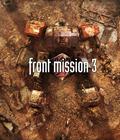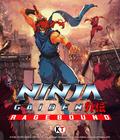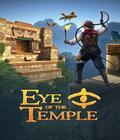Occasionally, you play a game that blows you away. It could be the very first game you've played, a rare masterpiece, or a game that plays from a new perspective. Playing my first VR game was one of these memories, as was playing Half-Life: Alyx for the first time. As someone who's invested in VR, things get underwhelming after that. There are a lot of amazing experiences, but it's rare to jump into a new VR game and feel like it's something giddy and exciting that you haven't experienced before.
Eye of the Temple is that game for me, and I almost passed on it for logical reasons, but I'm happy that I didn't. It's strictly a room-scale game, so there is no artificial locomotion. It requires a 2x2-meter play space (6x6 feet) to move around as you descend into a multi-layered temple full of traps and puzzles. You're equipped with nothing but a torch, a whip, and a hat that would make Indiana Jones proud.
After watching Indiana Jones and Lara Croft jump through ancient temples on a flat screen for decades, it was about time we get a VR game that lets us do that. Eye of the Temple is essentially that. We traverse an unknown temple, tile by tile, as we make our way to the inner sanctum of the complex. Things are rarely easy. Mechanical beetles, elaborate traps, and a few other surprises await as we forge ahead. Bite-sized pieces of background lore explain why we're here and where we're going, but the storytelling is relatively light. That may even work in the game's favor by keeping the mystery alive throughout the adventure. It's not so much about what you do but how you do it. Eye of the Temple doesn't require you to press a single button on your controller (except perhaps in the settings menu). Every action is performed by movement, either by walking in a direction or swinging your controllers, and it does this with an incredible amount of polish.
The game uses the 2x2-meter (6x6 feet) play space in clever ways. You either move from tile to tile in small steps, or you step on a rolling cylinder tile, which requires you to walk backward in order to move forward. It's simple on paper, but it immerses and tricks you quite convincingly, so it's easy to forget where you are within the play space. It's better to experience it than explain it, but the implementation is incredible. It takes about 10 minutes to get used to the movement, but once you get the hang of it, you'll be hooked. There are other room-scale experiences around, like Tea for God, that have similar movement concepts. Those titles often break immersion by obviously letting you run in circles wherever possible. I found the implementation here to be much more immersive and subtle in comparison. Simple movement alone isn't that entertaining, and Eye of the Temple ramps up the challenge of navigating the temple as you progress.
Soon you'll face an assortment of traps that you need to avoid, such as blocks that move or ducking under flamethrowers or the most classic of all — a falling ceiling that crushes you for being too slow. Before you know it, Eye of the Temple will have you ducking under a collapsing ceiling, while you balance on a cylinder and walk backward at the same that you're trying to switch a lever with your whip. It's not uncomfortable, but it puts you in situations where you'll die and need to repeat the section. For lack of a better term, Eye of the Temple feels like the next best thing to a room-scale platformer. There's no jumping involved, of course, but it requires good timing of your movements and some clever challenges. When you're not scurrying from platform to platform, you're trying to find the correct door to open.
Eye of the Temple has some interesting, large-scale puzzle sections that are fun to solve. For example, there's an area with several pillars that need to be rotated, so you need to figure out where to go and which lever to flip or which torch to light to create the path forward. You also collect gems, which can be exchanged for larger gems that are also used to progress. It's not something I had to focus on, but it gives you yet another activity on top of managing your movement, finding a way forward, and dodging ancient apparitions that want to skewer and roast you.
I love the whip, which can flip levers or fend off attacking bugs, but it didn't always play nice. When trying to hit objects below me, it was quite tricky to hit anything. Its implementation is good, and the whip is only available when you're standing in the middle of your play space, so you don't hit anything around you. It's a good indicator for the player to know where they are in their play space. Even though the game is rather short at about five hours (plus a fun speed run mode), it still introduces mechanics as you progress, so you won't be doing the same things over and over again. There's a minecart section that I expected, but I wasn't prepared for how much fun it would be. That's essentially how I'd describe my entire adventure in Eye of the Temple: surprising and engaging from start to finish, with fun and clever ideas throughout.
Eye of the Temple isn't necessarily a visual showcase, but it has its moments. The graphics are solid, but the real highlight is the scale. It's a great feeling to travel up a towering temple wall while stepping between moving platforms, some of which move inside the wall or pass through a narrow hole in the ground with you standing on it. You should reconsider playing this title if claustrophobia is a concern, though. Detailed murals, statues, and environments make the trip down the temple quite an experience. I want to call out the strong lighting system, especially when your torch is the only light source in a room as it throws ominous shadows everywhere. The music, on the other hand, is serviceable. It's not overly remarkable, but it fits the theme and gets the blood pumping when it needs to.
The game is not perfect, but the list of complaints is relatively manageable. In the early sections of the game, I had to rely on watching where I stepped so I wouldn't mess up my timing. That meant I was looking at my feet for a considerable amount of time, and that caused some neck strain. This eventually went away as I got more comfortable navigating the temple, but it's something to watch out for. Another concern is motion sickness. With a few exceptions, there is not the same potential for motion sickness in Eye of the Temple like in other games, but it's not entirely free from it. It fakes movement well enough, but if you step on a tile too fast or at the wrong time, it's possible to lose your balance or have your stomach lurch. This didn't go away as quickly as I would've liked. Late in the game, there were still a few odd moments when I got too daring and stepped on platforms that were already moving away from me, and they almost sent me flying to the side as I lost my (fictional) balance. If you're careful, this should be avoidable and not a mark against the game. If there is any, it's probably the play space requirements of 2x2 (6x6 feet) meters.
I don't have the smallest apartment, but it's compact, and I initially dismissed Eye of the Temple for that very reason. It turns out that if I move a significant amount of my furniture, I could narrowly get away with that space and about four inches of extra room on the sides. It isn't fun to move half of my inventory every time I want to play Eye of the Temple, but once I got to play, I wanted to do it again.
It was worth the effort every time, but it wasn't a perfect experience. I've run into walls several times during my playtime, which happens if you don't have any extra room (like me). In moments when the game required me to crouch at the edge of the allotted area, part of my body moved outside the space and bumped into a wall. One time, I accidentally sat in my Christmas tree. I've been streaming the game wirelessly to my Quest 2. Without the Quest, I would've had to relocate my PC to the room, and I'd probably run the risk of tripping on a cord. However finicky the setup was, I was always entertained (and mostly unharmed) by Eye of the Temple, and if you can satisfy the minimum space requirement, give it a go. Ideally, you'd want to have additional space of at least half a meter (18-19 inches) to either side and a wireless headset.
Eye of the Temple is a rare VR gem that caught me by surprise. Its natural and immersive room-scale movement system, rewarding puzzle sections, and overall scale are excellent. If you own a VR headset and have enough room to play, Eye of the Temple successfully proves the potential of VR.
Score: 9.3/10
More articles about Eye Of The Temple











 Eye Of The Temple is a VR game that lets you explore a vast and treacherous temple using your own feet.
Eye Of The Temple is a VR game that lets you explore a vast and treacherous temple using your own feet. 









